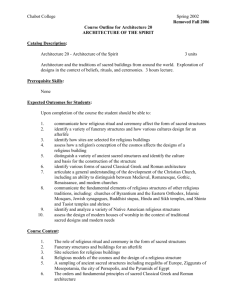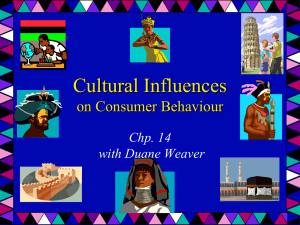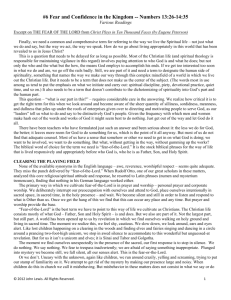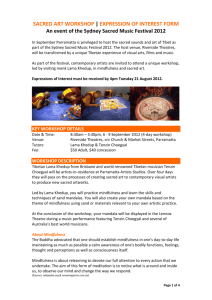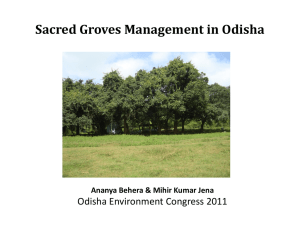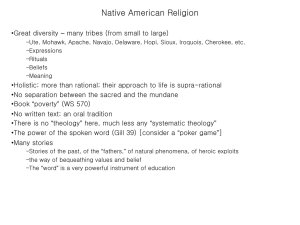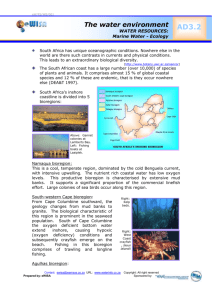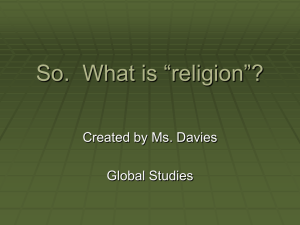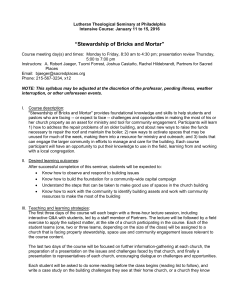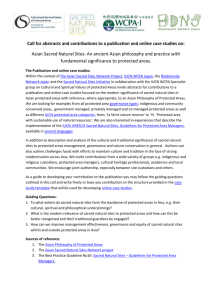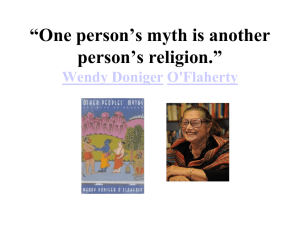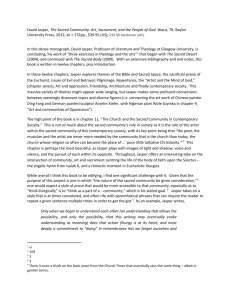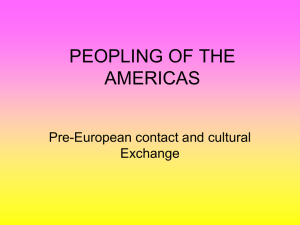Eco Spirituality PowerPoint
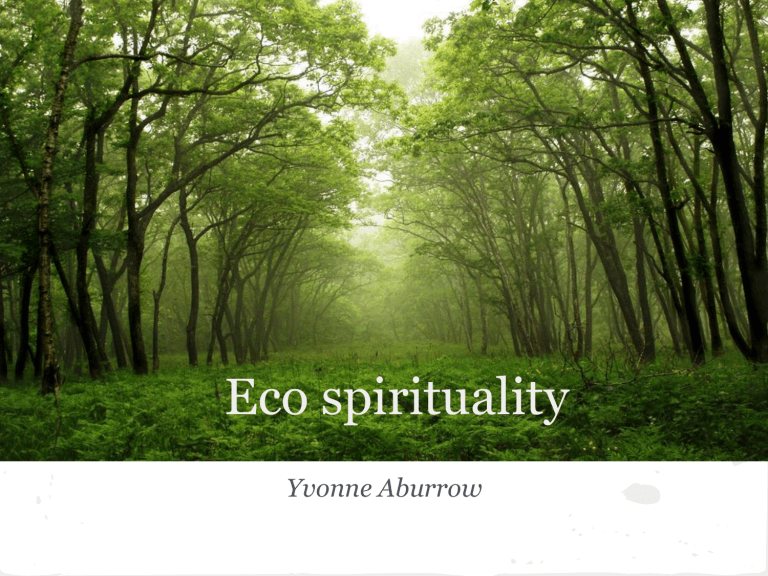
Eco spirituality
Yvonne Aburrow
Eco-spirituality: what is it?
• relating to your environment
• a non-violent spirituality and spiritual activism
• deep ecology - not human-centric
• sustainability
• working with Nature
Nonviolent
•
• respect for life in all its manifestations, human, nonhuman, animal, vegetable and mineral harmonious use of natural resources, with respect for the natural order and cycles of the environment, and development compatible with the ecosystem
• listening to Nature, not dictating to it
Sustainability
•
Caring for people and the environment
•
Social and environmental justice are linked
Deep ecology
•
Other species' right to exist is independent of their value to human needs
•
The diversity of eco-systems is important
•
A deep ecological approach is needed for sustainability
Eco-feminism
The idea that the exploitation of the
Earth is symbolically linked to the domination of women - talk of conquest, dominion etc. And respect for the
Earth = respect for women.
Working with Nature
•
Bioregions
•
"Small is beautiful"
•
Think global, act local
•
Recycling
•
Carbon footprint
•
Nature spirituality
•
Conversations with spirit of place
Process theology
• becoming
• unfolding
• emergent
• experiential
•
AN Whitehead
•
Charles Hartshorne
Unfolding Spacetime by suhurmash
Gaia theology & Gaia theory
•
Teilhard de Chardin
•
Oberon Zell
•
James Lovelock
•
Gaia, Rhea
activity 1: bioregion quiz
Please form groups of three and discuss these...
1) Point north.
2) What time is sunset today?
3) Trace the water you drink from rainfall to your tap.
4) When you flush, where do the solids go? What happens to the waste water?
5) How many feet above sea level are you?
6) What spring wildflower is consistently among the first to bloom here?
7) How far do you have to travel before you reach a different watershed? Can you draw the boundaries of yours?
bioregion quiz
8 ) Is the soil under your feet, more clay, sand, rock or silt?
9) Before your tribe lived here, what did the previous inhabitants eat and how did they sustain themselves?
10) Name five native edible plants in your neighborhood and the season(s) they are available.
11) From what direction do storms generally come?
12) Where does your garbage go?
13) How many people live in your watershed?
14) Who uses the paper/plastic you recycle from your neighborhood?
15) Point to where the sun sets on the equinox. How about sunrise on the summer solstice?
bioregion quiz
16) Where is the nearest earthquake fault? When did it last move?
17) Right here, how deep do you have to drill before you reach water?
18) Which (if any) geological features in your watershed are, or were, especially respected by your community, or considered sacred, now or in the past?
19) How many days is the growing season here (from frost to frost)?
20) Name five birds that live here. Which are migratory and which stay put?
21) What was the total rainfall here last year?
22) Where does the pollution in your air come from?
bioregion quiz
23) If you live near the ocean, when is high tide today?
24) What geological processes or events shaped the land?
25) Name three wild species that were not found here 500 years ago. Name one exotic species that has appeared in the last 5 years.
26) What minerals are found in the ground here?
27) Where does your electric power come from and how is it generated?
28) After the rain runs off your roof, where does it go?
29) Where is the nearest wilderness? When was the last time a fire burned through it?
30) How many days till the moon is full?
http://connectedbynature.com/2010/01/happy-2010-where-you-at-abioregional-quiz/
Carbon footprint
•
What is your personal ecological impact?
•
How many Earths are needed to sustain your lifestyle?
Ethical and ecological audit
•
Household
•
Personal
•
Food and drink
•
Transport
•
•
Fair Trade
•
Sustainability
Recycling
•
Pollution http://is.gd/eeaPagan
Spirit of place
•
Sense of presence / immanence / immediacy
/ personality at a particular locale
•
This does not have to be a "traditional" sacred space - could be your favourite place in the landscape
•
Build a relationship with your special places
- commune with them, make art, write poetry, do ritual there (ask the place first)
activity 2: visualise your special place
• take a moment to think of your place
• what do you love about it?
• how does it smell, feel, sound, look?
• what emotions does it evoke?
• write down 5 words to describe it
Tree of Life by Christy Freeman
The sit spot
Find a place outdoors and sit there everyday for at least 15 minutes.
• patterns in nature become apparent
•
"deepening sense of place" (Barry Patterson)
•
"subtle embodied communion with one chosen place can pattern a sacred relationship to the world" (Adrian
Harris)
Wildness
Instinct
Intuition
Connection
Intimacy
Freedom
Solitude
Nature
The seasons
• celebrate seasonal festivals
• keep a nature diary
• grow plants outside
• eat local seasonal fruit and vegetables (better for the environment)
Sacred landscape
• visit places, walk mindfully
• find out about geology, history, wildlife, place-names in your area
• draw a map or mandala of your local land forms (hills, rivers, woods, marshes, lakes)
activity 3: sacred geography
• sketch a mandala or map of your local area
• what elements (Earth,
Air, Fire, Water) would you associate with special places?
• are there any sacred springs, stone circles, sacred groves, chalk figures, etc in your area?
• local flora and fauna?
Wildflowers landscape mandala,
Lindy Longhurst
Further reading
Barry Patterson, The Art of Conversation with the Genius Loci
Gordon Maclellan,
Talking to the Earth
Clarissa Pinkola Estés,
Women who run with the wolves




